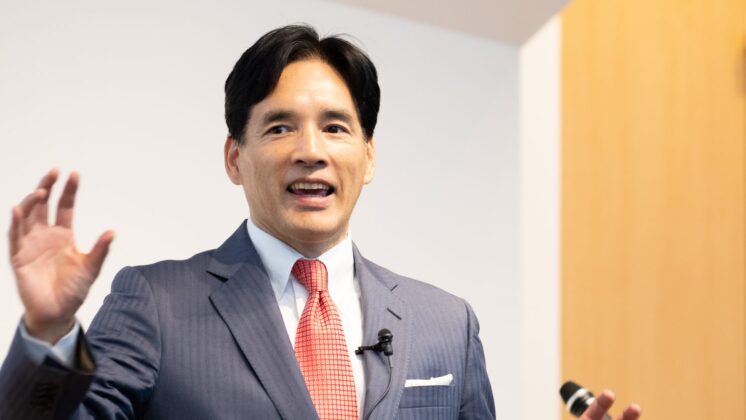I arrived for the second day of the Silicon Valley conference at 8, ready to participate from the very first session. I had never engaged completely, diligently in a conference from start to finish as I did at this one. Even when things got boring and my mind was worn out, I made sure I stayed with it right until the end. I had specifically come to Silicon Valley for this conference, so there were no excuses. I was bent on learning as much as possible from this.
There were some scheduling clashes. Entrepreneur presentations under the title “CEO’s Pitch” were held in a separate, smaller venue. I slipped out to watch one of these during a session on China, since I was already pretty familiar with that topic. I was surprised at how popular the CEO’s Pitch was. A mass of people was packed into the small venue.
These CEO presentations were far richer than those in Japan. CEOs from companies in their expansion stage with a given level of sales were welcomed onto the stage. People I assumed to be venture capitalists were eagerly listening. When I think about it, to make a presentation in a place like this provides a great opportunity to increase the recognition of a company.
Many of the companies originated in the U.S. If you’re not known in the U.S., you essentially don’t exist at all, so U.S. entrepreneurs conduct very aggressive PR. They try to stand out as much as possible, using newspapers, magazines, and recently, blogs. Even if you manage to get recognized and make enough money, ultimately, you still have to either sell or take the company public. Either way, the key is being well known. Most of the entrepreneurs participating in the CEO’s Pitch were from strongly performing companies that have received venture capital investment; yet, all of them had to clear the preliminary rounds of review to get this far.
That said, the CEO’s Pitch was presented under severe constraints. Each company had only 12 minutes to complete their formal presentation (5 minutes), and then field a question from each of three judges. Then, if there still was time, questions were taken from the audience. At 11 minutes, 30 seconds, the judges rendered their verdict, based on a possible score of 5 for each of three criteria: (1) Marketability, (2) Marketing, and (3) Overall Image.
The judges’ scores on these three criteria were added together, and the top three presentations received a commendation before the closing ceremony of the conference. At this point, every participant (including the webcast audience) would be given one minute to pitch. Under this system, anyone could become better known in one leap.
I observed the pitches of three companies, and they were rather interesting. One entrepreneur started out by saying, jokingly, “I believe in what I’m doing and really don’t like being evaluated in front of other people. To be honest, this is the last thing I wanted to be doing, so I hope you all give me a break.”
I think the central theme running through this conference was openness. Three different sessions included the word “open” in their titles: “Open Media Network,” “Open Source,” and “Open Web.” Here’s my brief summary of concepts from the discussions.
(1) Open Source, Open Standards
(2) Open Content
(2) Open Media Revolution
Open Source, Open Standards
This term was coined a long time ago, so it was nothing really new, although there were some interesting perspectives. In this session, COO and President of Sun Microsystems Jonathan Schwartz gave a presentation, followed by a panel discussion moderated by a venture capitalist from Kleiner Perkins Caufield & Byers.
The flow of the discussion went like this:
The top three companies (Microsoft, Oracle, SAP) earn 75% of all profits in the software world, and the top 15 companies account for 85% of profits. This makes it an oligarchy. All companies generating profits make the software available as open-source, but other companies are aggressively proceeding with creating more open-source software to win customers. In this situation, where a gap is evident, how to make a profit is a vital issue.
Open Content
This refers to abandoning copyrights for content and allowing content to be freely distributed via the internet. A charismatic entrepreneur named Mark Cuban vigorously extolled the virtues of this approach. Mark founded Broadband.com and then sold it to Yahoo! for nearly 600 billion yen. He now manages a video content distribution company called HDNet while also managing a pro NBA basketball team, so he’s the prototypical entrepreneur. This notion of open content really ignited heated controversy, with a raging debate between Silicon Valley and Hollywood.
The Open Media Revolution
This is primarily concerned with blogging. Nowadays, everyone can be a part of the media by just starting a blog. The debate was around how to make a profit in a time like this, and what the world would be like in five or ten years.
One word that kept coming up was “disruptive,” literally meaning a “discontinuous reform.” Disruption is a concept heralded by HBS Professor Clayton Christensen. This word is discussed all over the place. It really seems to express the spirit of American entrepreneurs.
Based on the discussion, it’s not really worth doing things small. We need to look at a global level for major projects that could follow in the footsteps of Yahoo! and Google. We must create a discontinuous revolution, and we need a revolutionary concept that makes current businesses into clichés.
It was impressive to hear everyone talk about what this concept really means and what kind of innovation is required while keeping an eye on the future.
This echoed what I myself said at the New Industry Leaders Summit (NILS), when I urged Japanese entrepreneurs not to rest on their laurels, but to think big and to think globally.
I was disappointed by two things at the conference. One was the discussion about wireless technology. Silicon Valley is the worldwide center of technology, yet you still cannot access the internet on a mobile phone there. Japan is storming ahead with wireless technology, so this panel offered nothing new for me.
Another disappointment was the discussion on China. It seemed everyone wanted to discuss China, but in very general terms. People talked about the market being large and growing. They talked about how there were many outstanding personnel in science and technology, but none of this resulted in any concrete discussion.
At the end of the second day, I was dropped off at the hotel by friends I had met at the conference. I had learned so much in a day of discussions in English about technology, with panelists all talking very fast―I felt like a student all over again. There were moments in the rapid pace of technical discussions in which my mind just couldn’t process fast enough and started shorting out, but overall I was able to fully participate in both days.
I want to continue investing through GLOBIS Capital Partners with the determination to create the next Sony or Honda. We have already produced Works Applications, the No. 1 company in the area of ERP, and GDH, the No. 1 company in digital animation. Both are now expanding into global operations.
I really want to continue creating companies with the ability to transmit Japan to the rest of the world. There are many companies in which we have invested that could follow these two. I really sense that they have huge potential. More importantly, though, I won’t be satisfied until we turn out 50 or even 100 venture companies that are capable of creating entirely new industries. These are the kinds of entrepreneurs I want knocking on the door of GLOBIS.



